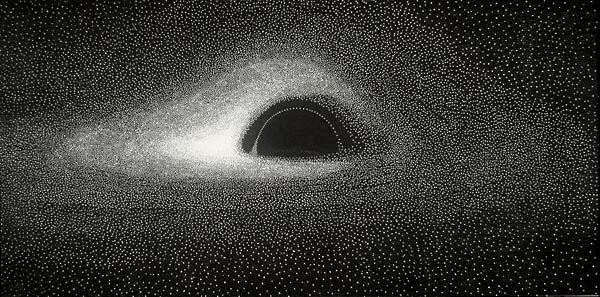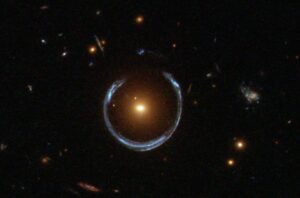Ever since we’ve known they exist, humans have wondered what it would be like to plummet into a black hole.
Black holes, the celestial objects so massive they are capable of trapping light and “spaghettifying” anything that falls in, have also captured our collective imagination. Astronomers found signs of the first known black hole system, Cygnus X-1, inside the Milky Way in 1964.
But snapping a decent photo of one has proven painstaking. Prolonged attention finally produced the first image of a black hole — a “fuzzy orange donut” designated M87 — in 2019.
View this post on Instagram
Yet all along, astrophysicists were hard at work behind computers, running thousands of encoded mathematical equations to simulate black holes’ shape and behavior. In fact, since the 1970s, simulations have represented the bleeding edge of the field.
Compare the indistinct orange donuts to the detail in the below image, generated by French astrophysicist Jean-Pierre Luminet on an IBM 7040 computer — in 1979.

Using numerical data from the computer, Luminet drew directly on negative image paper with black India ink, placing dots more densely where the simulation showed more light. Photo: ResearchGate
Best simulation yet
Fast forward to 2024, where Jeremy Schnittman, an astrophysicist at NASA’s Goddard Space Flight Center, specializes in creating these advanced simulations. We struggle to know what happens inside black holes, but Schnittman’s two latest videos advance the state of the art.
In them, a simulated camera plunges toward the mysterious singularity at the center of a black hole in ultra-high definition.
“People often ask about this, and simulating these difficult-to-imagine processes helps me connect the mathematics of relativity to actual consequences in the real universe,” Schnittman told ExplorersWeb.
It’s the first project that shows The simulated black hole resembles Sagittarius A, the supermassive object at the center of the Milky Way. (Researchers in 2022 released orange donut photos of it, and used Einstein’s theory of relativity to model what it might look like at higher resolution.)
The simulated expanses in Schnittman’s videos are massive. “Sgr A*” weighs as much as 4.3 million suns and yawns 23.5 million kilometers wide. But it only takes the camera a few simulated seconds to reach it from a distance of 640 million kilometers, then teeter past the event horizon into its inescapable depths.
Schnittman admitted the simulation does not try to depict reality perfectly. First, Sgr A* has an indistinct accretion cloud rather than the razor-sharp disc in the video. And the background is the sky as seen from Earth, rather than from any black hole — because, well, we’ve never photographed the sky from near a black hole.
A 127,232-core supercomputer
Regardless, the effort was intensive enough. Rendered at 8K, 60fps, the ten terabytes of video footage would have taken a decade to generate on a conventional laptop. Instead of toiling in darkness, Schnittman teamed up with fellow Goddard scientist Brian Powell to use the Discover supercomputer at the NASA Center for Climate Simulation.

The 127,232-core Discover supercomputing cluster can perform 8,100 trillion operations per second. Photo: Creative Commons
“It takes anywhere from a few minutes to a few hours to create one frame of a video like this with the requisite calculations,” Schnittman explained. “So multiply that by 10,000 times, and you need a supercomputer: processors running in parallel.
The compulsion to enter a black hole resembles our fascination with their powerful, sinister connotations. Yes, there is enough gravity inside that not even light can escape. No, we still don’t know what happens at the singularity, where the laws of physics break and math no longer functions.
Spaghettification
But along the way, we do know you would get “spaghettified” — basically, the difference between the gravitational force pulling at your feet and pulling at your head is so enormous that your body would get stretched into a super-elongated, thin noodle.
It’s still possible to escape spaghettification, though, as long as you don’t come close enough to touch the event horizon. This region, inside an orbiting circle of light called the photon ring, takes no prisoners. If it were possible to live inside it for more than a few seconds, you could perceive objects beyond it, but nothing at all could come out.
NASA’s simulations depict both fates — one instance of getting swallowed by the black hole and one of narrowly escaping. In the death scenario, the simulated camera passes the photon ring and approaches the event horizon. The perception of time on board speeds up as gravity increases. Once the camera enters the event horizon, it experiences time outside the black hole as infinite.
“The camera is destroyed. Microseconds later, it reaches the singularity.”
That mirrors one of Schnittman’s professional fantasies — albeit not his first choice.
A cool way to go
“Is [spaghettification] the final glory for an astrophysicist? It would be a cool way to go. I think I’m still going to opt for the lying in bed, surrounded by your loved ones, route,” Schnittman joked.
Schnittman is part of a NASA project team tasked to develop a space telescope that could capture the first images of a black hole from outer space. Situated tens of thousands of kilometers away from Earth, it would send back higher-resolution images of — orange donuts.
“It will make all these images much sharper — something like 10 times sharper,” Schnittman said. “The funny thing is, since the simulations existed well before the orange donut was known, we’re not trying to go back and understand the donut. Instead, the donut was exciting to us because we saw it and were like, ‘A-ha! Look, we were right after all.”
The project he describes is half a decade and hundreds of millions of dollars away from implementation. For now, black hole gazers should keep concentrating on one place in the known universe — YouTube.






